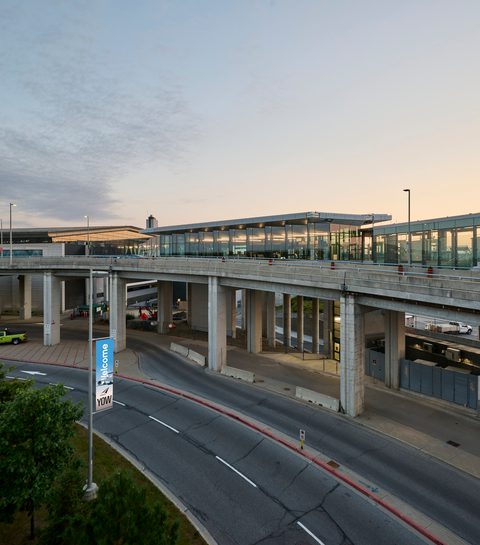Remarks to the Canadian Transportation Agency – Mark Laroche


Notice of Oral Hearing
IN THE MATTER OF
The Canadian Transportation Agency's (CTA) inquiry into Air Transat tarmac delays for flights
No. 157 from Brussels and No. 507 from Rome, on July 31, 2017.
Case No.: 17-03788
Good afternoon. My name is Mark Laroche, and I am the President and CEO of the Ottawa International Airport Authority. I am pleased to have the opportunity to address the panel to ensure clarity where the Ottawa Airport Authority’s actions of July 31st are concerned.
First, let me say that I fully appreciate the frustration and anger of the passengers who were affected during diversions on the evening in question. After delays and long trans-Atlantic flights, I have no doubt that each and every person would have preferred to return home much more quickly. The Authority has a deep-rooted commitment to providing excellent customer service, and we agree that it was not acceptable that passengers waited on aircraft in subpar conditions, as was the case for some on July 31st. We hope that this process assists in finding solutions to avoid such situations in the future.
Second, I also want to stress that safety is the Airport Authority’s first priority. During an irregular operation, or IRROP, such as the one that occurred on July 31st, we must respect NAV CANADA’s decision to divert aircraft to our airport and work with them to facilitate getting the aircraft on the ground and in the best position to meet their needs while they are unexpected guests. It’s safer to have aircraft on the ground in Ottawa rather than circling or being diverted to an airport further away in what may be a low fuel situation.
About Airport Authorities in Canada – Roles and Responsibilities
Airport authorities in Canada are private not-for-profit corporations that were established to manage and operate airports in accordance with ground leases with the Minister of Transport. They are responsible for operating their respective airports in a safe, efficient, cost effective and financially viable manner. They provide major infrastructure to facilitate air carrier movement and passenger processing, enforce airport safety regulations, provide emergency response and services, and a central command in the form of an Airport Operations Centre.
However, airport authorities are not responsible for aircraft marshalling, refuelling, catering and baggage handling, many of the items that are at the heart of the issue before the panel today. All of these tasks fall within the purview of the airlines or their contracted ground handlers or agents. The scope of these services is detailed under contracts directly with the carriers. The Authority is not privy to the terms of these contractual arrangements; however, they have been included in various testimonies submitted to this panel.
Not only is the Authority not responsible for these tasks, it does not own ground equipment such as air stairs, portable ground power or air conditioning units, baggage tugs or fuel trucks, nor does it have employees who are trained to operate these pieces of equipment. It is of note that the scope of the Authority’s responsibilities has been confirmed in the various written testimonies provided by Air Transat, First Air and ASIG.
Overview of July 31st
Though, it is not my intention to recount every fact of July 31, or to detail the Authority’s response on that date, I would, however, like to summarize how this IRROP played out against the backdrop of the airport’s regular peak evening operation. The full timeline and pertinent details can be found in the Authority’s submission[1], and I assure you that the information presented is taken from detailed logs and reports that are generated in the regular course of business.
We were advised by NAV CANADA that ground stops went into effect in Toronto and Montreal at 14:18 and 15:00 respectively. As with most weather related IRROPs, our airport had little, if any, advance warning on the number and type of aircraft we were about to receive. In the end, the diverted aircraft included an A380, several 787s, 737s, triple 7s and various other aircraft types and sizes carrying more than 6,000 unexpected air travellers on 20 diverted flights, more than 5,000 of whom were on flights from international destinations. Our regular operation during the same hours included 44 arrivals and 44 departures with more than 4,000 passengers travelling each way. I refer you to the story boards we developed to demonstrate the number of aircraft on the airfield from both the regular and irregular operations that evening. [2]
Parking positions for the diverted aircraft were carefully determined by Authority staff and air traffic control, based on size, aircraft servicing requirements and the information that was provided by various parties at the time. We likened the task of parking these very expensive assets as a game of Tetris, where unknown pieces of a puzzle drop quickly and must be properly fitted into available space based on the specific configuration of the individual pieces. This analogy should not minimize the importance of ensuring the safety and security of the aircraft by careful placement to prevent damage. I refer to our submission to visualize the number of aircraft, the order in which they arrived, where they were parked during the IRROP and movement that took place as space freed-up. The Air Transat aircrafts were purposely parked together to facilitate efficient servicing by their ground handler and refueller.
Aircraft began moving to Toronto by 16:59 and Montreal at 18:40. The last diverted flight to depart was Air Transat 157 at 22:59. The shortest stay was 60 minutes and the longest was five hours and 51 minutes. I also want to be very clear that gates were available, or could be made available on short notice, to deplane passengers at the terminal throughout the entire event. Although photographs of empty gates with timestamps were presented to the inquiry officer on August 15, 2017, we have resubmitted these photographs, along with further photographs of empty gates and the Authority’s gating chart for that evening in order to corroborate this fact, as our statement in that respect is itemized as “uncorroborated” in the CTA investigator’s report.
Though none of the passengers were deplaned, Authority staff, including the Operations Responder and Emergency Response Service team, was required to board an aircraft due to calls to the City’s 9-1-1 dispatch for a reported medical emergency. While on-board, these Airport Authority employees were concerned with the high temperature of the aircraft and passenger requests for drinking water. These concerns were addressed by these employees who requested that all doors be opened, and by distributing Authority-supplied bottled water. It should be noted that the Airport Authority does not board aircraft unless permitted to; on July 31st, we boarded TS157 only in response to the 9-1-1 calls received by the City of Ottawa which indicated medical emergencies on-board. It should also be noted that the Authority does not offer catering services during regular or irregular operations – these services are arranged by the airline with a third party provider.
The role of airport authorities in irregular operations due to diversions is to use specific training and experience to ensure that the airport remains open and that regular operations can be carried out – all with a view to preventing even more passengers from having their travel plans delayed or cancelled. We facilitate any support an airline or their ground handler might require as the IRROP unfolds.
Perhaps most importantly, an airport authority has no jurisdiction with respect to a flight being gated and/or offloaded. As noted in Air Transat’s Tariff, “the aircraft at all times shall be under the exclusive control of the pilot-in-command, whose orders shall be strictly complied with”. The carrier should have protocols for diversions and further, should assure that their pilots and contracted third party refuelers and ground handlers are fully aware of these practices. The airline has an obligation to ensure its pilots understand the protocols and contractual relationships so that, if required, they can act on them. We note instances in submitted statements and media statements[3] that Air Transat was under the mistaken belief that the refueller and ground handlers are somehow under the control of the Authority[4]. I must reiterate that this is not the case. In its submission, First Air, the ground handler contracted by Air Transat, includes a copy of their contract with Air Transat which details staffing levels, equipment requirements, and service standards that further demonstrate this point.
How YOW Helped
Regardless of these roles and restrictions, on the night in question, our staff reached out multiple times to Air Transat’s ground handler in an effort to understand the airline’s plan and to ensure they knew that a gate and other support was available as needed. We would have been happy to inform the refueller of the critical low fuel condition affecting TS157 in the same way we informed them of KLM’s imminent crew timeout. No such concern was ever expressed and, specifically, the four Air Transat flights were described by the ground handler to Authority employees who were working on the tarmac as “gas and go”. Additionally, reference has been made to an Air Canada aircraft being refuelled on the taxiway. While this activity is rarely allowed, permission was sought by the carrier and granted due to the level of accreditation of their staff with respect to airside operations.
Airlines are responsible for their own customer care; however, the Authority has a Passenger Care Response Plan in place as a backup. Through the plan, the Authority can deploy certain assets as needed, when that need is expressed. On July 31st, the Authority put several parts of its plan in motion, including deploying buses to transport passengers to the terminal, as well as taking bottled water to the plane. The program lead was ready to help upon request. None was requested, but the team was ready.
It should be noted that despite the assistance available through the Passenger Care Plan, normal delay times will degrade, as the Air Transat Director of Flight Safety recognized in his submitted remarks[5]. CBSA, CATSA, U.S. CBP and other agencies that operate at the airport do not have sufficient staff on the ground to handle large diversions on a 24-7 basis. Furthermore Ottawa’s airport terminal is not designed to receive a sudden and unpredictably large amount of international travellers if all or several diverted airlines make the decision to deplane. It’s also important to note that as the Air Transat Director of Flight Safety and both Flight Captains indicated in their testimonies[6], deplaning TS507 and TS157 would likely have resulted in crew time-out due to the time it would take to deplane the passengers, process them through Canada Customs, check them back-in and security screen them.
I hope my remarks have helped clarify the roles and relationships between the various parties involved in the events of July 31st, in particular, that the Airport Authority is not responsible for many of the activities at the heart of this inquiry. We do not provide ground services such as refuelling, we do not have equipment such as air stairs and GPUs, and we are not responsible for deplaning passengers. We provide support services to ensure that the needs of the airlines and its agents are facilitated in the safest manner possible.
Conclusion
I would like to conclude by commending Authority staff for going above and beyond to provide assistance and ensure the safety and security of all visiting aircraft and passengers. As an Air Emirates pilot[7] described in a note he sent to the Authority the following day, he was, quote: quite impressed by the level of knowledge and support your staff gave us. End quote. Given that this pilot was maneuvering an A380 aircraft at an unfamiliar airport with no issues, I would say that’s high praise.
We would be pleased to answer any questions the panel may have. Thank you. Merci.
[1] CYOW Submission, Appendix 1
[2] CYOW Submission, Appendix 2
[3] Air Transat Statement Released August 1, 2017
[4] Air Transat Flight Director’s Written Declaration, points 84, 86, 93, 96
[5] Air Transat Director of Flight Safety’s Written Declaration points 44-45
[6] Air Transat Flight Captains Written Declarations
[7] CYOW Submission, Appendix 5
